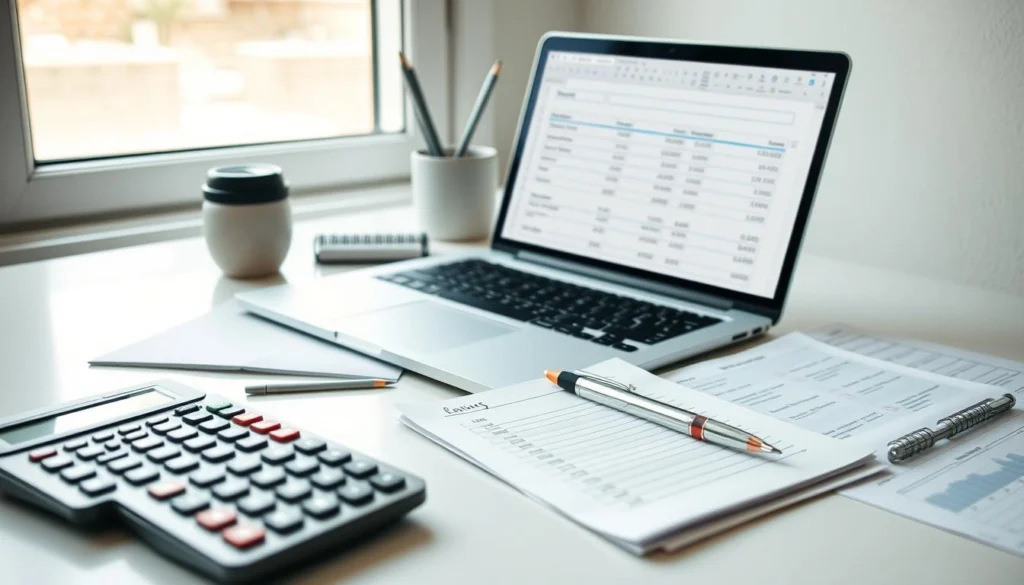Ever wonder why so many people struggle with personal finance, even though they know they need to start a budget? The truth is, budgeting isn’t about complex math or endless spreadsheets it’s about understanding your money journey.
Many avoid budgeting because they think it’s too complicated. But it’s actually simpler than you think. Starting a budget is about creating a clear plan for your money one that fits your life, goals, and priorities.
Key Takeaways
- Budgeting doesn’t require advanced math skills
- Simple strategies can transform your financial health
- Understanding your spending is more important than complex calculations
- Anyone can create an effective budget with the right approach
- Financial success is about consistency, not perfection
Understanding Your Financial Starting Point
Starting a budget means knowing your financial status. You need to see your income and expenses clearly. This helps you make a budget that meets your financial goals.
Think of your budget as a financial roadmap. To navigate well, focus on three key areas. These are calculating net income, identifying fixed expenses, and tracking variable expenses. Tracking your expenses is key to this.
Calculating Your Net Income
Your net income is what you get after taxes and deductions. It’s not your total salary but what you actually get. To find this:
- Look at your latest pay stubs
- Subtract taxes, retirement, and other deductions
- Write down your take-home pay
Identifying Fixed Expenses
Fixed expenses stay the same every month. They are important for planning your budget.
| Expense Category | Typical Monthly Cost |
|---|---|
| Rent/Mortgage | $1,200 – $2,000 |
| Utilities | $150 – $300 |
| Insurance | $100 – $500 |
| Car Payment | $250 – $500 |
Tracking Variable Expenses
Variable expenses change each month. Careful tracking helps you see your spending. Use apps, spreadsheets, or notebooks to keep track.
- Groceries
- Dining out
- Entertainment
- Personal care
Mastering these three areas sets a strong budget foundation. It makes tracking and allocating income easier.
Breaking Free from Math Anxiety in Budgeting

When you hear “budget,” you might think of hard math. But, money management is simple. It’s about making your finances easy to handle.
Math anxiety stops many from managing their money. It makes budgeting seem too hard. But, you can feel confident about your finances without being a math whiz.
- Recognize that budgeting is about understanding your spending, not solving complex equations
- Focus on tracking money flow rather than performing intricate calculations
- Use technology to simplify financial tracking
Today’s tools make budgeting easy for all. Apps and digital platforms track your spending. They show you how your money is doing in simple ways.
| Traditional Budgeting Challenge | Modern Solution |
|---|---|
| Manual expense tracking | Automated expense categorization |
| Complex calculations | Instant financial summaries |
| Spreadsheet complexity | User-friendly mobile apps |
Good financial planning is about healthy money habits. Start small, stay consistent. Don’t let math fears stop you from reaching your financial goals.
Essential Tools for Easy Budget Management
Managing your money doesn’t have to be hard. Today’s tech offers great budgeting apps and tools. They make tracking your finances easy and clear.
Digital tools have changed how we handle money. They make budgeting simple by sorting expenses and showing your spending habits clearly.
Top Budgeting Apps to Streamline Your Finances
- Mint: Free comprehensive budget tracking
- YNAB (You Need A Budget): Proactive financial planning
- Personal Capital: Investment and budget management
- Goodbudget: Envelope budgeting method digital version
Spreadsheet Templates for DIY Budgeters
If you like to manage your money yourself, try spreadsheet templates. Google Sheets and Microsoft Excel have templates for budgeting. They’re easy to use, even if you’re not good at math.
| Template Type | Key Features | Difficulty Level |
|---|---|---|
| Monthly Budget Planner | Income tracking, expense categorization | Beginner |
| Savings Goal Tracker | Visual progress monitoring | Intermediate |
| Debt Reduction Spreadsheet | Loan payoff calculations | Advanced |
Quick Budget Calculators
Online budget calculators give you quick financial insights. They help you figure out your spending and savings goals. You don’t need to do hard math.
Pro tip: Pick tools that fit your comfort level and update them often for accurate tracking.
The Envelope System: A Math-Free Budgeting Method
Managing money can be tough, especially if you’re not good with numbers. The envelope system is a simple way to live frugally without needing to do math.
Here’s how it works: You put your cash into physical envelopes, each for a different spending area. This hands-on method lets you see your budget without getting confused by numbers.
- Create envelopes for essential categories like:
- Groceries
- Utilities
- Entertainment
- Transportation
- Put a specific amount of cash in each envelope
- Only spend what’s in each envelope
In today’s digital age, you can use budgeting apps that work like the envelope system. Virtual envelopes let you track spending online while keeping the same budgeting idea.
| Envelope Category | Monthly Allocation | Spending Tracking |
|---|---|---|
| Groceries | $400 | Physical/Digital Tracking |
| Utilities | $250 | Bill Payments |
| Entertainment | $100 | Cash/App Tracking |
The envelope system is all about simplicity. By separating your money physically or digitally, you set clear spending limits. This makes managing money easy and stress-free.
Start a Budget with the 50/30/20 Rule

Starting a budget can seem hard. The 50/30/20 rule makes it easy. It’s a simple way to manage your money without getting lost in numbers.
This rule divides your after-tax income into three parts:
- 50% for Needs: Things like rent, utilities, food, and minimum debt payments
- 30% for Wants: Money for fun, like going out, dining, and hobbies
- 20% for Savings and Debt Repayment: For emergency funds, retirement, and paying off debt
Understanding the Basic Percentages
This method makes budgeting simple. It sets clear limits for spending. The 50% for needs covers your basic costs.
The 30% for wants lets you enjoy life without losing focus. And the 20% for savings helps secure your financial future.
Adjusting Ratios to Your Situation
Maybe you need to tweak the 50/30/20 rule. If you live in a pricey area or have a lot of debt, adjust the percentages. The rule is meant to be flexible, so tailor it to your needs.
The aim is to make budgeting easy and stress-free. It helps you reach your financial goals smoothly.
Creating Automatic Savings Plans
Automating your savings is a big change in personal finance. It makes managing money easier. By setting up automatic transfers, you save time and effort. This way, you build a strong financial base.
To begin your automatic savings, follow these tips:
- Link your checking account to a dedicated savings account
- Schedule recurring monthly transfers on payday
- Start with small, manageable amounts you won’t miss
- Gradually increase your automatic savings percentage
Many banks and apps make saving easy. Capital One 360, Ally Bank, and Chime offer tools to round up purchases. They then transfer the extra to your savings.
Your savings plan should match your financial goals. Saving for emergencies, vacations, or retirement is key. Small, regular transfers can add up to a lot over time. The trick is to keep it simple and make saving easy.
Pro tip: Set up different savings streams for various goals. This way, you save for different things without getting lost in complex plans.
Smart Ways to Track Spending Without Complex Math
Tracking your spending doesn’t have to be hard. Good expense tracking can make managing your money easier without needing to do hard math. The trick is to find a method that fits your life well and doesn’t feel like a burden.
Many people find it hard to track their finances because they think it needs complex spreadsheets or hard math. But, you can keep an eye on your spending with simple, easy-to-use methods that match your style.
Digital Tracking Methods
Digital tools have changed how we track expenses, making it easier than ever. Here are some popular digital options:
- Budgeting apps with automatic expense categorization
- Bank mobile apps with spending insights
- Digital wallets that track purchases in real-time
These digital tools give you instant visibility into your spending without needing to do math. Most apps can show you your spending in a way that’s easy to understand.
Paper-Based Systems
If you like something you can hold in your hand, paper-based tracking can work well. Some simple ways include:
- Daily expense notebooks
- Envelope budgeting system
- Receipt collection and manual categorization
No matter what method you pick, the key is to keep tracking regularly. Start simple, stay consistent, and you’ll see your money management skills get better over time.
Reducing Fixed Expenses to Improve Your Budget

Fixed expenses can take up to 50% of your monthly income. To save money, you need to think smart about your biggest financial commitments.
Start your frugal living journey by looking closely at your recurring expenses. Many people miss chances to cut costs that seem fixed but can change.
- Negotiate monthly bills like internet and phone services
- Shop around for better insurance rates annually
- Cancel unused subscriptions and memberships
- Consider bundling services for potential discounts
Housing is usually the biggest fixed expense for families. Strategic approaches can help lower this cost:
- Explore roommate options
- Refinance your mortgage if interest rates have dropped
- Investigate smaller living spaces
- Consider relocating to more affordable neighborhoods
| Expense Category | Potential Monthly Savings |
|---|---|
| Phone Plan | $20-$50 |
| Internet Service | $15-$40 |
| Insurance Bundling | $50-$100 |
| Subscription Audit | $10-$30 |
Managing fixed expenses well can change your financial situation. Even small changes can lead to big savings. This gives you more financial freedom without needing to constantly watch your spending.
Simple Grocery Budgeting Techniques
Grocery spending can quickly get out of hand without a plan. Frugal living begins in the kitchen, where smart planning cuts down monthly costs. By using targeted saving tips, you can turn your grocery budget into a well-managed resource.
Planning Your Grocery Budget
Effective grocery budgeting needs a clear plan. Your choice between weekly or monthly planning depends on your lifestyle and goals. Each method has its own benefits for managing food expenses.
- Weekly Planning:
- Allows for more flexible spending
- Reduces food waste
- Easy to track and adjust
- Monthly Planning:
- Potential for bulk purchasing
- Less frequent shopping trips
- Better for long-term budget predictability
Smart Shopping Strategies
Save money with these practical grocery shopping tips:
- Create a detailed meal plan before shopping
- Use cash or prepaid cards to limit spending
- Compare prices across different stores
- Leverage store loyalty programs
- Buy seasonal produce
By following these saving tips, you can cut down your grocery costs while still eating well. Frugal living is not about giving up quality. It’s about making smart choices that save money and improve your health.
Managing Variable Expenses Without Stress
Variable expenses can quickly derail your money management efforts if left unchecked. These costs like dining out, entertainment, and shopping can create financial uncertainty. It’s crucial to track and control these expenses for a healthy budget.
Start by categorizing your variable expenses into realistic groups. This approach helps you see where your money goes each month. Consider these primary categories:
- Entertainment
- Dining out
- Personal shopping
- Miscellaneous purchases
Implement a proactive strategy for managing these expenses. Set realistic spending limits for each category. Use digital tools or cash envelopes to stay within your budget. Many budgeting apps offer real-time tracking and automatic categorization, making money management easier than ever.
Another effective technique is using a separate bank account or prepaid card for discretionary spending. By allocating a fixed amount monthly, you create a natural barrier against overspending. This method provides financial flexibility while preventing budget disruptions.
Track your variable expenses weekly to catch potential overages early. Review your spending patterns and adjust your budget accordingly. Small, consistent monitoring prevents financial stress and helps you stay in control of your financial journey.
Building Emergency Funds and Long-Term Savings
Creating a strong financial safety net is simple. It doesn’t need complex math or deep knowledge of personal finance. Emergency funds protect you from sudden problems, giving you peace of mind and stability.
Experts suggest saving for 3-6 months of living costs. Start with a goal that feels reachable, so you don’t feel overwhelmed.
- Begin with $500 as an initial emergency fund target
- Automate small monthly contributions
- Keep emergency savings in a separate, easily accessible account
- Gradually increase savings as your income grows
For long-term savings, aim for steady, small increases. Even $25 per month can make a big difference over time.
| Savings Goal | Monthly Contribution | Annual Total |
|---|---|---|
| Emergency Fund | $50 | $600 |
| Retirement Savings | $100 | $1,200 |
| Investment Fund | $75 | $900 |
Personal finance is about making progress, not being perfect. Your savings journey starts with one step and steady effort.
Conclusion
Starting a budget doesn’t need fancy math skills. It’s about making choices that help you reach your financial goals. Simple steps and consistent effort can change how you see money.
Your budget should fit your lifestyle. Choose a method that works for you, like apps, spreadsheets, or the envelope system. Every step you take towards managing money brings you closer to financial security.
Starting a budget is a personal and powerful journey. Start with small steps. Track your spending, set achievable goals, and be kind to yourself. As you go, you’ll grow more confident in your financial decisions.
The best personal finance plans are ones you can keep up with. Your budget is a tool, not a limit. It helps you make smart choices, lowers stress, and builds the life you dream of.


2 thoughts on “How to Start a Budget from Scratch (Even If You Hate Math)”
Comments are closed.